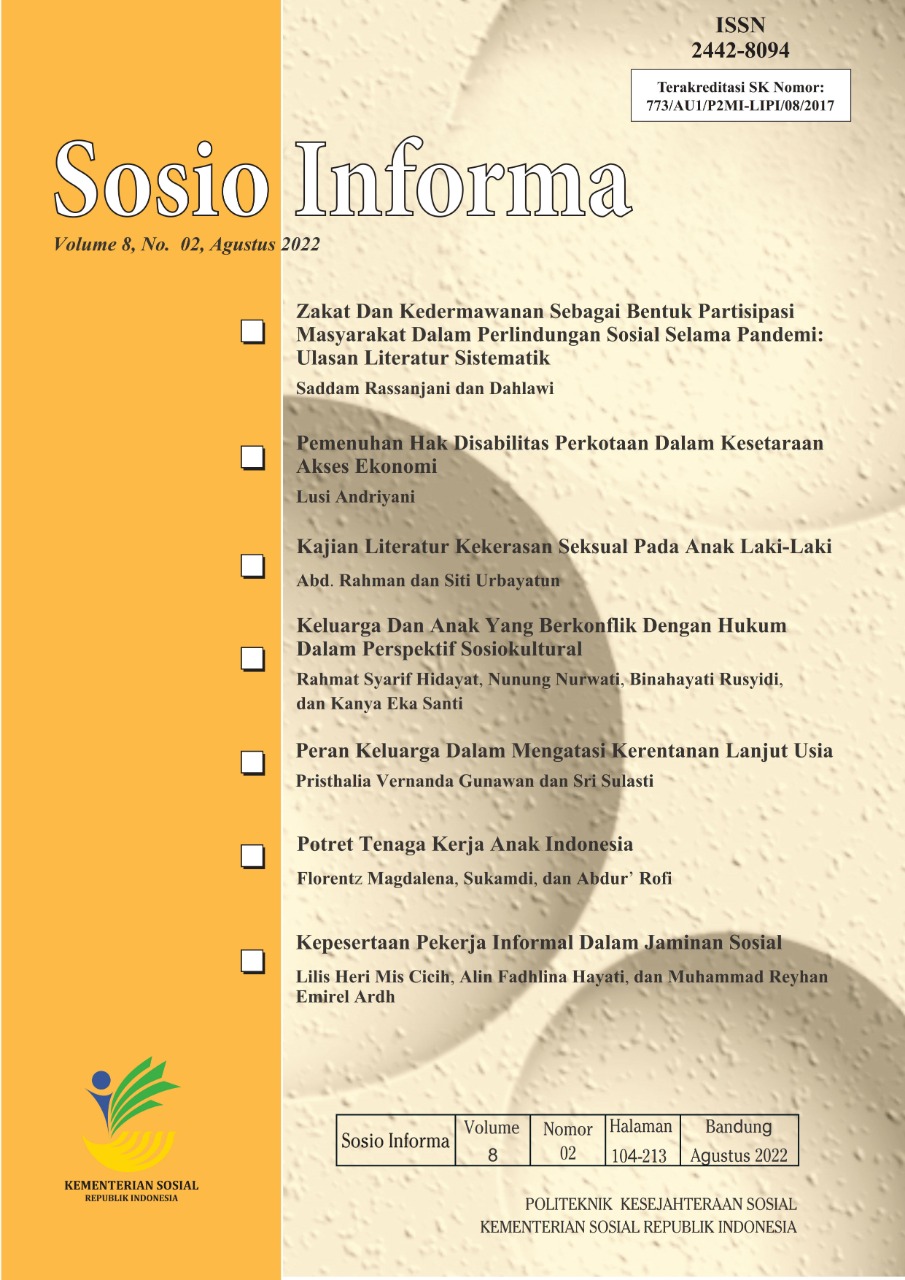KEPESERTAAN PEKERJA INFORMAL DALAM JAMINAN SOSIAL
DOI:
https://doi.org/10.31595/inf.v8i2.2683Keywords:
jaminan sosial, cakupan kesehatan semesta (uhc), jaminan kesehatan nasional (jkn), pekerja formalAbstract
Jaminan sosial di Indonesia masih perlu diperhatikan terutama untuk pekerja informal, yang jumlahnya lebih besar dari pekerja formal (sekitar 60,0% berbanding 40,0%). Jumlah yang besar ini berkontribusi terhadap pembangunan sehingga perlu memperoleh perlindungan baik dari segi kesehatan maupun ketenagakerjaannya. Pekerja informal masih banyak yang belum tercakup dalam jaminan sosial. Artikel ini bertujuan untuk memberikan gambaran kepesertaan pekerja informal dalam jaminan kesehatan dari segi sosial ekonomi demografi tahun 2016 dan 2018. Informasi yang disajikan merupakan hasil analisis data sekunder, ditunjang sumber referensi terkait lainnya. Hasil analisis data Survei Sosial Ekonomi Nasional (Susenas) tahun 2016 sebanyak 44,0% pekerja informal belum berpartisipasi dalam kepesertaan jaminan kesehatan, dan tahun 2018 menurun menjadi 41,7%. Sebagian besar pekerja informal termasuk kepesertaan yang disubsidi pemerintah atau Penerima Bantuan Iuran (PBI). Pada tahun 2016 pekerja informal penerima PBI sebesar 37,6%, dan menurun menjadi 36,8 % pada tahun 2018. Berdasarkan karakteristiknya, kepesertaan jaminan kesehatan pekerja informal paling banyak pada pendidikan tinggi, status ekonomi 20,0% tertinggi, tinggal di perkotaan, dan mengalami keluhan kesehatan. Kepesertaan pekerja informal dalam jaminan kesehatan dianggap masih rendah, merupakan tantangan untuk memberikan perlindungan kepadanya. Hal ini terkait dengan karakteristik pekerja informal yang didominasi oleh pendidikan dan pendapatan rendah. Pendidikan pekerja informal yang rendah terkait dengan kurangnya kesadaran dan pengetahuan tentang jaminan kesehatan. Status ekonomi pekerja informal yang rendah (40% terendah) menjadi kendala dalam kepesertaan jaminan kesehatan non subsidi. Perlu meningkatkan sosialisasi dan edukasi kepada pekerja informal terkait pentingnya kepemilikan jaminan kesehatan. Selain itu, perlu dirancang skema pembiayaan bagi pekerja informal sehingga jaminan sosial tidak memberatkan mereka.
References
Acharya, A., Vellakkal, S., Taylor, F., Masset, E., Satija, A., Burke, M., & Ebrahim, S. (2013). The impact of health insurance schemes for the informal sector in low-and middle-income countries: A systematic review. World Bank Research Observer, 28(2), 236–266. https://doi.org/10.1093/wbro/lks009
Adewole, D. A., Akanbi, S. A., Osungbade, K. O., & Bello, S. (2017). Expanding health insurance scheme in the informal sector in Nigeria: awareness as a potential demand-side tool. The Pan African Medical Journal, 27, 52. https://doi.org/10.11604/pamj.2017.27.52.11092
Ahmed, S., Hoque, M. E., Sarker, A. R., Sultana, M., Islam, Z., Gazi, R., & Khan, J. A. M. (2016). Willingness-to-pay for community-based health insurance among informal workers in urban bangladesh. PLoS ONE, 11(2). https://doi.org/10.1371/journal.pone.0148211
Akhmad Purnama. (2014). Analisis Perlindungan Jaminan Sosial bagi Pekerja Informal Analyze on Social Insurance and Protection of Informal Workers.
Badan Pusat Statistik. (2017). Statistik Penduduk Lanjut usia 2017. In Badan Pusat Statistik.
Cometto, G., & Campbell, J. (2016). Investing in human resources for health: Beyond health outcomes. Human Resources for Health, 14(1). https://doi.org/10.1186/s12960-016-0147-2
Dartanto, T., Fachrul Rezki, J., Hanum Siregar, C., Bintara, H., & Pramono, W. (2015). Teguh Dartanto EXPANDING UNIVERSAL HEALTH COVERAGE IN THE PRESENCE OF INFORMALITY IN INDONESIA: CHALLENGES AND POLICY IMPLICATIONS LPEM-FEUI Working Paper Expanding Universal Health Coverage in the Presence of Informality in Indonesia: Challenges and Policy Implications.
Douglas Webb., R. Small. , and E. G. (2019). Universal Health Coverage for Sustainable Development Issue Brief.
Hafsari, T. A., & Seftiani, S. (2022). National Health Security as an Effort to Increase Social Welfare: Challenges on Informal Sector Participants in Yogyakarta Special Region.
Hermann Pythagore Pierre Donfouet; Ephias Makaudze; Pierre-Alexandre Mahieu; Eric Malin. (2011). The determinants of the willingness-to-pay for community-based prepayment scheme in rural Cameroon. International Journal of Health Care Finance and Economics. - Norwell, Mass. [u.a.]: Springer, ISSN 1389-6563, ZDB-ID 2067121-0, 11(3), 209–220.
Hidayatullah, A. N., Gutomo, T., Gutomo, D. T., Penelitian, B. B., Pelayanan, P., Sosial, K., Sosial, K., & Sosial, R. J. K. (n.d.). Aksesibilitas Keluarga Miskin dalam AKSESIBILITAS KELUARGA MISKIN DALAM PROGRAM JAMINAN KESEHATAN NASIONAL ACCEPTABILITY FOR POOR FAMILY IN NATIONAL HEALTH ASSURANCE PROGRAM.
Idris, H. 1; S. E. 2; T. L. 3; (2017). Determinant of Health Insurance Ownership in the Informal Sector: A Panel Study from Indonesia Family Life Survey. American Scientific Publishers, 23.
ILO. (2003). FACTS ON Social Security in Africa.
Indonesia, R. (1999). Undang-Undang No . 39 Tahun 1999 Tentang: Hak Asasi Manusia. Pusat Penerbitan, PNRI, 39, 43.
Indonesia, R. (2004). uu no 40 tahun 2004.
Jia, L., Yuan, B., Huang, F., Lu, Y., Garner, P., & Meng, Q. (2014). Strategies for expanding health insurance coverage in vulnerable populations. In Cochrane Database of Systematic Reviews (Vol. 2014, Issue 11). John Wiley and Sons Ltd. https://doi.org/10.1002/14651858.CD008194.pub3
Kementerian Kesehatan RI. (2017). Profil Kesehatan Indonesia Tahun 2017.
Pangestika Viona Febya, J. S. P. S. V. F. P. S. P. J. A. S. (2017). Faktor-faktor yang berhubungan dengan kepesertaa ns ektor informal. JURNAL KESEHATAN MASYARAKAT (e-Journal), 5(3).
Republik Indonesia. (2011). Undang-Undang Republik Indonesia Nomor 24 Tahun 2011 Tentang Badan Penyelenggara Jaminan Sosial.
UN. (2015). Ensure healthy lives and promote well-being for all at all ages.
WHO(World Health Organisation). (2019). Life expectancy at age 60 (years). In Who. https://www.who.int/data/gho/data/indicators/indicator-details/GHO/life-expectancy-at-age-60-(years)
Downloads
Published
How to Cite
Issue
Section
Citation Check
License
Copyright (c) 2022 Lilis Heri Mis Cicih

This work is licensed under a Creative Commons Attribution-NonCommercial-ShareAlike 4.0 International License.
Authors who publish with this journal agree to the following terms:
- Authors retain copyright and grant the journal right of first publication with the work simultaneously licensed under a Creative Commons Attribution-NonCommercial-ShareAlike 4.0 International License that allows others to share the work with an acknowledgement of the work's authorship and initial publication in this journal.
- Authors are able to enter into separate, additional contractual arrangements for the non-exclusive distribution of the journal's published version of the work (e.g., post it to an institutional repository or publish it in a book), with an acknowledgement of its initial publication in this journal.
- Authors are permitted and encouraged to post their work online (e.g., in institutional repositories or on their website) prior to and during the submission process, as it can lead to productive exchanges, as well as earlier and greater citation of published work (See The Effect of Open Access).









